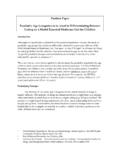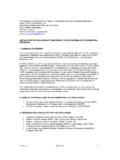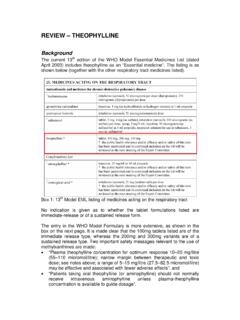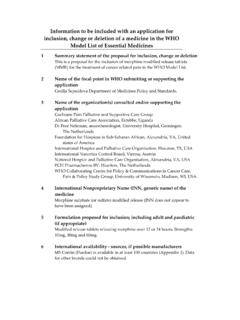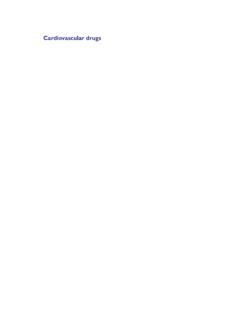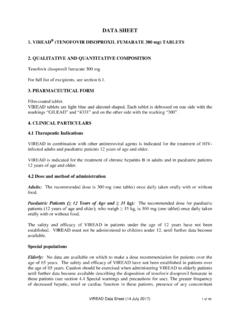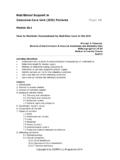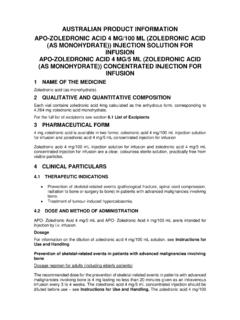Transcription of Gastrointestinal drugs - WHO archives
1 Gastrointestinal drugs Antacids and other antiulcer drugs Antacids (usually containing aluminium or magnesium compounds) can often relieve symptoms in ulcer dyspepsia and in non-erosive gastro-oesophageal reflux; they are also sometimes used in non-ulcer dyspepsia but the evidence of benefit is uncertain. Antacids are best given when symptoms occur or are expected, usually between meals and at bedtime, 4 or more times daily; additional doses may be required up to once an hour. Conventional doses for example 10 ml 3 or 4 times daily of liquid magnesium . aluminium antacids promote ulcer healing, but less well than antisecretory drugs (such as an H2 -receptor antagonist); proof of a relationship between healing and neutralizing capacity is lacking. Liquid preparations are more effective than solids. Aluminium- and magnesium-containing antacids (for example aluminium hydroxide, and magnesium hydroxide), being relatively insoluble in water, are long- acting if retained in the stomach.
2 They are suitable antacids for most purposes. Magnesium-containing antacids have a laxative effect whereas aluminium-containing antacids may be constipating. H2 -receptor antagonists heal gastric and duodenal ulcers by reducing the secretion of gastric acid as a result of histamine H2 -receptor blockade; they can also relieve gastro-oesophageal reflux disease. High doses of H2 -receptor antagonists have been used in the Zollinger Ellison syndrome, but a proton-pump inhibitor is now preferred. Maintenance treatment with low doses has largely been replaced in Helicobacter pylori positive patients by eradication regimens (see below). Maintenance treatment may occasionally be used for those with frequent severe recurrences and for the elderly who suffer ulcer complications. Treatment of undiagnosed dyspepsia with H2 -receptor antagonists may be acceptable in younger patients but care is required in older people because their symptoms may be caused by gastric cancer.
3 H2 -receptor antagonist therapy can promote healing of NSAID-associated ulcers (particularly duodenal). Treatment also reduces the risk of acid aspiration in obstetric patients at delivery ( Mendelson syndrome). PEPTIC ULCER. Ulcer disease is caused by peptic ulceration that involves the stomach, duodenum, and lower oesophagus. General and inexpensive measures like introducing healthy life-style, stopping smoking and taking antacids should be promoted. The possibilitiy of malignant disease should be considered in all patients over the age of 40 years who are suspected of having an ulcer. Gastric and duodenal ulcers are healed by 4 8 weeks treatment with H2 -receptor antagonists but there is a high rate of relapse (greater than 70% over 2 years) requiring maintenance therapy. Relapses can be prevented very sucessfully by eradicating Helicobacter pylori which is causally associated with most peptic ulcers (except those related to NSAID use).
4 Eradication of H. pylori reduces the relapse rate to about 4 8%. This is undoubtedly cost-effective compared to the alternatives of long-term maintenance therapy with low-dose H2 -receptor antagonists or repeated treatment of recurrent ulcers. It is recommended that the presence of H. pylori is confirmed before starting eradication treatment, particularly for gastric ulcers. The urea breath test is used widely to test for H. pylori , but it may produce false negative results if used soon after proton pump inhibitors or antibacterials. Eradication regimens are based on a combination of an acid-reducing ( antisecretory') drug and antibiotics. The following model eradication regimen is suggested on the basis of its efficacy and simplicity (only doses suitable for adults are shown): omeprazole 40 mg daily for 1 week plus metronidazole 400 mg three times daily for 1 week plus amoxicillin 500 mg three times daily for 1 week The decision on choosing an eradication regimen for a particular country should take into account local resistance to antibacterials, cost and availability of the necessary drugs .
5 NSAID-ASSOCIATED ULCERS. Gastrointestinal bleeding and ulceration may occur with NSAID use. To avoid this, emphasis should be on stopping NSAID use but this is not always possible. A proton pump inhibitor may be considered for protection against NSAID-associated gastric and duodenal ulcers. An H2 -receptor antagonist may be effective for protection against NSAID-associated duodenal ulcers only. Patients who must continue NSAID therapy after ulcer development may take high- dose H2 -receptor antagonists concomitantly, but ulcers tend to heal more slowly with H2 -receptor antagonists if NSAIDs are continued. A proton-pump inhibitor such as omeprazole is more effective but it is also more expensive. In patients who can discontinue NSAID therapy after ulcer development, treatment with an H2 -receptor antagonist is effective, but a treatment period of up to 8 weeks may be necessary. A proton pump inhibitor usually produces the most rapid healing.
6 After healing, continued prophylaxis is required. DYSPEPSIA. Dyspepsia covers pain, fullness, early satiety, bloating, or nausea. It can occur with gastric and duodenal ulceration and gastric cancer but most commonly it is of uncertain origin. Patients with non-ulcer dyspepsia should be advised to avoid smoking, alcohol and aggravating foods, and to eat small regular meals to aid digestion. Non-ulcer dyspepsia tends to be self-limiting but antacids and H2 -receptor antagonists are often used to suppress gastric acid. Effective treatment is important in the presence of severe oesophageal ulceration to prevent longer term complications such as oesophageal stricture and carcinoma. GASTRO-OESOPHAGEAL REFLUX DISEASE. Gastro-oesophageal reflux disease (including non-erosive gastro-oesophageal reflux and erosive oesophagitis) is characterized by symptoms which include heartburn, acid regurgitation, and sometimes difficulty in swallowing (dysphagia); oesophageal inflammation (oesophagitis), ulceration, and stricture formation may occur and there is an association with asthma.
7 The management of gastro-oesophageal reflux disease includes drug treatment, lifestyle changes and, in some cases, surgery. Initial treatment is guided by the severity of symptoms and treatment is then adjusted according to response. For mild symptoms of gastro-oesophageal reflux disease, initial management may include the use of antacids. H2 -receptor antagonists suppress acid secretion and they may relieve symptoms and permit reduction in antacid consumption. Severe symptoms initially require a short-course of a proton-pump inhibitor. ZOLLINGER ELLISON SYNDROME. Management of Zollinger Ellison syndrome requires high dose H2 -receptor antagonist treatment. The proton pump inhibitors are more effective particularly for cases resistant to other treatment but they are more expensive. Aluminium hydroxide Tablets , aluminium hydroxide 500 mg Oral suspension , aluminium hydroxide 320 mg/5 ml Uses: ulcer and non-ulcer dyspepsia; gastro-oesophageal reflux; hyperphosphataemia Contraindications: hypophosphataemia; undiagnosed Gastrointestinal or rectal bleeding; appendicitis.
8 Porphyria Precautions: impaired renal function and renal dialysis (Appendix 4); hepatic impairment (Appendix 5); constipation; dehydration; fluid restriction; Gastrointestinal disorders associated with decreased bowel motility or obstruction; interactions: Appendix 1. Dosage: Dyspepsia, gastro-oesophageal reflux, by mouth , ADULT 1 2 tablets chewed 4. times daily and at bedtime or 5 10 ml suspension 4 times daily between meals and at bedtime; CHILD 6 12 years 5 ml up to three times daily Hyperphosphataemia, by mouth , ADULT 2 10 g daily in divided doses with meals Patient Do not take other medicines within 2 4 hours of aluminium hydroxide preparations. May Advice. be taken with water to reduce constipating adverse effects Adverse effects: constipation; intestinal obstruction (large doses); hypophosphataemia with increased bone resorption, hypercalciuria and risk of osteomalacia (patients on low phosphate diet or prolonged therapy); hyperaluminaemia resulting in osteomalacia, encephalopathy, dementia, microcytic anaemia (in chronic renal failure treated with aluminium hydroxide as phosphate-binding agent).
9 Magnesium hydroxide Oral suspension , magnesium hydroxide equivalent to magnesium oxide 550 mg/10. ml Uses: ulcer and non-ulcer dyspepsia; gastro-oesophageal reflux Contraindications: severe renal impairment Precautions: renal impairment (Appendix 4); hepatic impairment (Appendix 5); interactions: Appendix 1. Dosage: Dyspepsia, gastro-oesophageal reflux, by mouth , ADULT 5 10 ml repeated according to patient's needs Adverse effects: diarrhoea; in renal impairment hypermagnesaemia resulting in loss of deep tendon reflexes and respiratory depression, with other symptoms including nausea, vomiting, flushing of skin, thirst, hypotension, drowsiness, confusion, muscle weakness, bradycardia, coma and cardiac arrest Ranitidine Ranitidine is a representative H2 -receptor antagonist. Various drugs can serve as alternatives Tablets , ranitidine (as hydrochloride) 150 mg Oral solution , ranitidine (as hydrochloride) 75 mg/5 ml Injection (Solution for injection), ranitidine (as hydrochloride) 25 mg/ml, 2-ml ampoule Uses: benign gastric and duodenal ulceration, gastro-oesophageal reflux, Zollinger Ellison syndrome, other conditions where gastric acid reduction is beneficial Contraindications: porphyria Precautions: hepatic impairment (Appendix 5); renal impairment (Appendix 4); pregnancy (Appendix 2); breastfeeding (Appendix 3); middle-aged or older patients and those whose symptoms change may mask gastric cancer; interactions: Appendix 1.
10 Dosage: Benign gastric and duodenal ulceration, by mouth , adult 150 mg twice daily or 300. mg at night for 4 8 weeks, up to 6 weeks in chronic episodic dyspepsia, and up to 8. weeks in NSAID-associated ulceration (in duodenal ulcer 300 mg can be given twice daily for 4 weeks to achieve a higher healing rate); maintenance, 150 mg at night;. CHILD (peptic ulcer) 2 4 mg/kg twice daily, maximum 300 mg daily Benign gastric and duodenal ulceration, reflux oesophagitis, Zollinger Ellison syndrome, by intramuscular injection , adult 50 mg every 6 8 hours or by slow intravenous injection , 50 mg diluted to 20 ml and given over at least 2 minutes, may be repeated every 6 8 hours or by intravenous infusion , 25 mg/hour for 2 hours, may be repeated every 6 8 hours Duodenal ulceration associated withH. pylori , see notes above Prophylaxis of NSAID-induced duodenal ulcer, by mouth , adult 150 mg twice daily Reflux oesophagitis, by mouth , adult 150 mg twice daily or 300 mg at night for up to 8 weeks, or if necessary 12 weeks (moderate to severe, 150 mg 4 times daily for up to 12 weeks); long-term treatment of healed oesophagitis, 150 mg twice daily Zollinger Ellison syndrome, by mouth , adult 150 mg 3 times daily; up to 6 g daily in divided doses has been used Gastric acid reduction (prophylaxis of acid aspiration) in obstetrics, by mouth , adult 150 mg at onset of labour, then every 6 hours.
